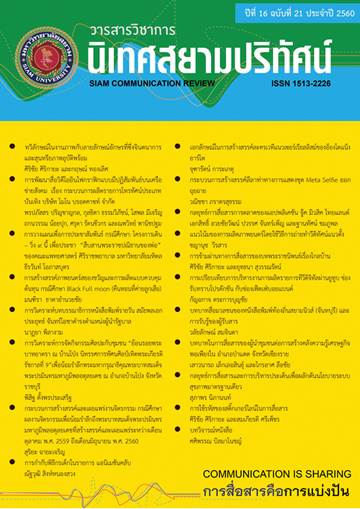Using the Code of Line Stickers for Communication
Main Article Content
Abstract
This article aims to study the code that present in the Line Stickers for communication. Line Stickers were collected by Top 5 Creator Market by Link Official Website from July, 2015 - December,2016 there are 14 sets and 544 characters. From the study, Line Stickers were presented in cartoon form which using cartoon code to create which compose of two code which are presentational code and representational code—these two sub codes were separated into other codes such as facial code, body language code, clothing code, humorous code, language code, social code and signs which are the main component to conduct the meaning including connotation and denotation. Therefore, the user must have the same encoding and decoding to interpret the same meaning. Also, the meaning of each Line Stickers can be flexible depends on the context. Finally, Speech Acts is related to the Line Stickers because both text and character is main component to conduct the meaning that hidden the purpose and intention such as message that hidden the purpose to expect the receiver to follow, or hidden some requests and including the order that hidden in the text.
Article Details
References
นุชนารถ เพ็งสุริยา. (2549). การใช้ภาษาเพื่อแสดงการตำหนิของคนไทย. วิทยานิพนธ์ปริญญามหาบัณฑิต, มหาวิทยาลัยธรรมศาสตร์.
ประสพโชค นวพันธ์พิพัฒน์. (2540). การใช้รหัสที่ปรากฏในงานของนักเขียนการ์ตูนไทย. วิทยานิพนธ์ปริญญามหาบัณฑิต, จุฬาลงกรณ์มหาวิทยาลัย.
ศักดา วิมลจันทร์. (2548). เข้าใจการ์ตูน. กรุงเทพมหานคร: เรือนแก้วการพิมพ์.
อรวรรณ ปิลันธ์โอวาท. (2546). กรอบวาทกรรมวิเคราะห์กับกรณีศึกษาไทย. กรุงเทพมหานคร: จุฬาลงกรณ์มหาวิทยาลัย.
ภาษาอังกฤษ
Fiske, J. (1982). Introduction to Communication Studies. New York: Methuen & Co. Ltd.
ออนไลน์
ธาม เชื้อสถาปนศิริ. (2558). ถอดรหัส นวัตกรรมความสำเร็จ LINE. เข้าถึงได้จาก : http://positioningmag.com/57820


